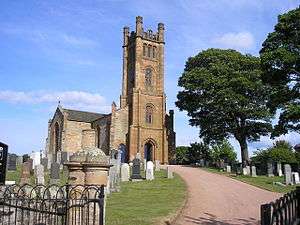Kilconquhar
Kilconquhar (/kɪˈnjʌxər/ (![]()
![]()
The coastal village and royal burgh of Earlsferry was formerly in the parish, but in 1891 the burgh and that part of the parish south of the (now disused) Fife Coast Railway line and Cocklemill Burn was transferred to the parish of Elie.[7]
History
Kilconquhar Castle was formerly owned by the Adams of Kilconquhar. Adam of Kilconquhar married Marjorie, Countess of Carrick to become the Earl of Carrick. Adam went to the Crusades with Prince Edward of England and died in Acre. His widow subsequently married Robert de Brus, 6th Lord of Annandale, who thus became Earl of Carrick and Lord of Kilconquhar. Their son was Robert the Bruce.[8][9]
There was another castle in the parish called Rires or Reres, belonging to the Forbes family. Margaret Beaton, Lady Reres, was a companion of Mary, Queen of Scots, and her husband Arthur Forbes was involved in the assassination of John Wood.[10] The ruins of the castle were demolished and cleared away in the 19th-century.
In the 18th century the village was noted as a weaving centre. This industry employed 235 persons in 1856[5] but faded in the late 19th century. The population was at a high in 1836 of 558 but dropped to 350 in 1881. By 2011 it had fallen to just over 200.
Parish Church
Kil in the name implies an early Christian origin for the church, but no early remains or carved stones of the period have been identified. The situation of the medieval parish church, on a mound near a loch, is a typical one for early sites.
Kilconquhar Parish Church is within the Church of Scotland. The historic church building is still in regular use; it is an exact, but larger scale, copy, of Cockpen and Carrington Parish Church in Midlothian[11] has an unusually tall tower for such a small parish.
Mention of Saint Conquhar, a Scottish Saint, is found only in the 15th-century Perth Psalter. His saint's day is noted as May 3.[12]
The new church was planned in 1818 and designed by R & R Dickson in 1819, based on Cockpen Church which they had overseen the construction of, following the death of its designer, their employer Richard Crichton.[13] The church opened in 1821. It contains several fine stained glass windows including "The Acts of Charity" by Ward and Hughes installed in 1867 and four biblical warriors installed in the 1920s by Mrs Andrew Grant in memory of her four nephews lost in World War I.[8]
The church bell was donated by Robert, son of the Countess Dowager of Crawford, in the mid 19th century, but is an 18th-century bell, formerly in Greenwich Hospital.[8][11]
The remains of Old Kilconquhar Church lie in the churchyard. This was originally called Culdee Church and is first mentioned in 1177. In 1200 Duncan, Earl of Fife bestowed revenues from this church to the Cistercian nunnery in North Berwick. The church was consecrated in 1243 by Bishop de Bernham. In 1499 Patrick Dunbar, Laird of Kilconquhar, set up an altar to "Our Lady of Pitie (Pity)".
Other notable buildings
The local pub is the Kinneuchar Inn. It dates from the 18th century.[3]
Lochside Farm, Allan Cottage and Woodlands all date from the mid 18th century.
Notable Residents
- James Drummond was minister for 1681 to 1699.[14]
- Rev William Milligan was minister of the parish from 1850 to 1860 and his son George Milligan was born here in 1860.
- Rear Admiral William Duddingston was born at St Ford on the southern edge of the parish.
Kilconquhar gallery
 Kilconquhar village, church and war memorial
Kilconquhar village, church and war memorial Kilconquhar old church ruins
Kilconquhar old church ruins Kilconquhar Parish Church
Kilconquhar Parish Church Kilconquhar old church ruin, and new church
Kilconquhar old church ruin, and new church Kilconquhar Church east window
Kilconquhar Church east window Kilconquhar Inn
Kilconquhar Inn Kilconquhar Loch and Church
Kilconquhar Loch and Church Kilconquhar Castle
Kilconquhar Castle
References
- Taylor, Simon; Gilbert Márkus (2009). The Place-Names of Fife, Vol. III. Donington, Lincolnshire: Shaun Tyas. pp. 303–6. ISBN 978-1-900289-97-9.
- "Fife Place-name Data :: Kilconquhar". fife-placenames.glasgow.ac.uk.
- "Kilconquhar, Fife". Gazetteer for Scotland. Retrieved 22 December 2014.
- Ordnance Gazetteer of Scotland, by Francis Groome, 2nd edition 1896; article on Kilconquhar
- The Topographical, Statistical, and Historical Gazetteer of Scotland. II. Fullarton. 1856. p. 105.
- "About Us". largowardchurch.org.uk.
- Ordnance Gazetteer of Scotland, by Francis Groome, 2nd edition 1896; article on Earlsferry
- Kilconquhar: A Hidden Gem by Jean Lindesay-Bethune 2011
- MacGibbon, David; Ross, Thomas (4 June 1887). "The castellated and domestic architecture of Scotland from the twelfth to the eighteenth century". Edinburgh : D. Douglas – via Internet Archive.
- Pitcairn, Ancient Criminal Trials, vol. 1 (Edinburgh, 1833), p. 40.
- Mitchell, Robin I. (January 1965). "A Bell Called The Countess". The Scots Magazine: 365.
- admin (14 July 2009). "History of Kilconquhar Church". www.eastneuktrinity.org.uk.
- Dictionary of Scottish Architects: Dickson
- Dick, Robert (1896). Annals of Colinsburgh: With Notes on Church Life in Kilconquhar Parish. Edinburgh: Andrew Elliot. pp. 123–126. Retrieved 5 March 2019.
| Wikimedia Commons has media related to Kilconquhar. |